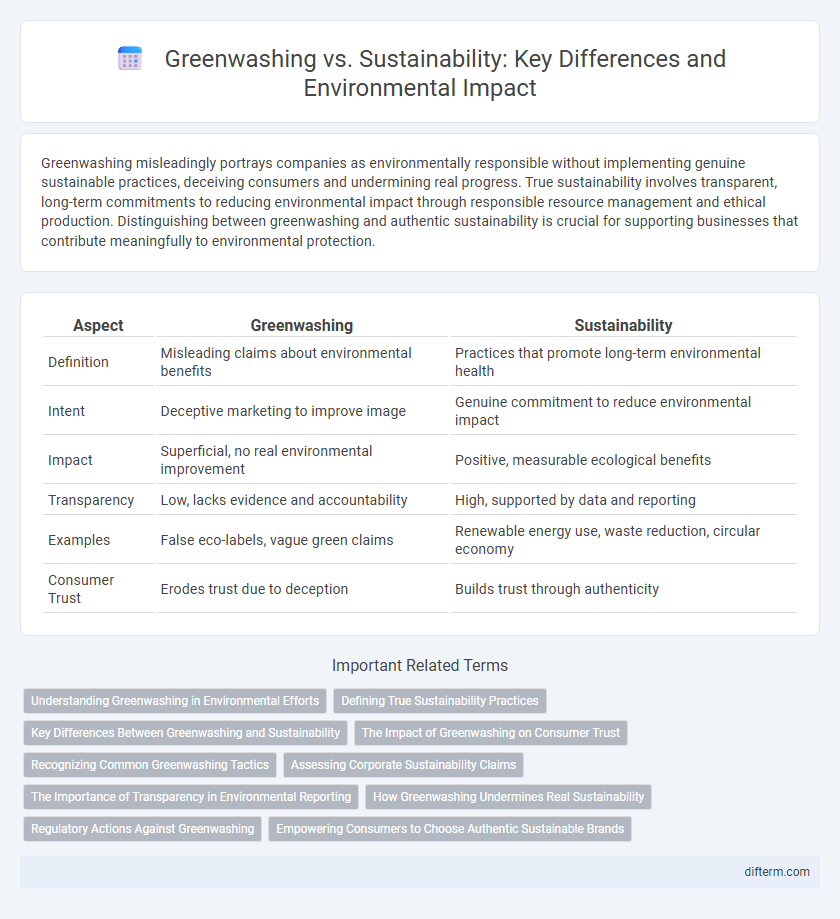Greenwashing misleadingly portrays companies as environmentally responsible without implementing genuine sustainable practices, deceiving consumers and undermining real progress. True sustainability involves transparent, long-term commitments to reducing environmental impact through responsible resource management and ethical production. Distinguishing between greenwashing and authentic sustainability is crucial for supporting businesses that contribute meaningfully to environmental protection.
Table of Comparison
| Aspect | Greenwashing | Sustainability |
|---|---|---|
| Definition | Misleading claims about environmental benefits | Practices that promote long-term environmental health |
| Intent | Deceptive marketing to improve image | Genuine commitment to reduce environmental impact |
| Impact | Superficial, no real environmental improvement | Positive, measurable ecological benefits |
| Transparency | Low, lacks evidence and accountability | High, supported by data and reporting |
| Examples | False eco-labels, vague green claims | Renewable energy use, waste reduction, circular economy |
| Consumer Trust | Erodes trust due to deception | Builds trust through authenticity |
Understanding Greenwashing in Environmental Efforts
Greenwashing involves companies misleading consumers by portraying their products or policies as environmentally friendly when they lack genuine sustainability efforts. Identifying greenwashing requires scrutiny of claims against measurable environmental impact, such as carbon footprint reduction, resource conservation, and transparent reporting. True sustainability incorporates verified practices that balance ecological health, social responsibility, and economic viability beyond marketing rhetoric.
Defining True Sustainability Practices
True sustainability practices involve reducing environmental impact through renewable energy use, waste minimization, and resource conservation rather than superficial marketing claims. Greenwashing often exaggerates or falsifies environmental benefits, misleading consumers and stakeholders about a company's genuine ecological efforts. Transparent reporting and third-party certifications are essential to distinguish authentic sustainability initiatives from deceptive greenwashing tactics.
Key Differences Between Greenwashing and Sustainability
Greenwashing involves misleading claims by companies about the environmental benefits of their products or practices, often exaggerating or fabricating green credentials to attract eco-conscious consumers. In contrast, sustainability focuses on genuine efforts to reduce environmental impact through responsible resource management, long-term ecological balance, and transparent reporting. The key difference lies in the intent and authenticity: greenwashing prioritizes marketing over real environmental progress, while sustainability commits to measurable and verifiable ecological improvements.
The Impact of Greenwashing on Consumer Trust
Greenwashing undermines consumer trust by misleading buyers about a company's environmental practices, causing skepticism toward genuine sustainability efforts. Studies show that 60% of consumers feel deceived when greenwashed claims are exposed, leading to reduced brand loyalty and decreased market share for offending companies. Trust recovery requires transparent reporting and verified sustainability certifications to rebuild authentic consumer confidence.
Recognizing Common Greenwashing Tactics
Common greenwashing tactics include vague claims, misleading labels, and irrelevant certifications that falsely suggest environmental benefits. Companies often use eco-friendly buzzwords without providing verifiable evidence or transparent data on sustainability practices. Identifying these strategies requires scrutinizing product ingredients, supply chain accountability, and third-party certifications aligned with recognized environmental standards.
Assessing Corporate Sustainability Claims
Corporate sustainability claims often require rigorous assessment to distinguish genuine environmental efforts from greenwashing practices that mislead stakeholders. Transparent disclosure of carbon footprints, resource usage, and third-party certifications enhances the credibility of sustainability reports. Independent audits and adherence to globally recognized standards like GRI or SASB reduce the risk of false claims and promote authentic corporate responsibility.
The Importance of Transparency in Environmental Reporting
Transparency in environmental reporting is crucial to distinguish genuine sustainability efforts from greenwashing, where companies falsely portray eco-friendly practices. Accurate, verifiable data on emissions, resource usage, and waste management enables stakeholders to assess real environmental impact and hold organizations accountable. Open disclosure of sustainability goals and progress fosters trust and drives meaningful improvements in corporate environmental responsibility.
How Greenwashing Undermines Real Sustainability
Greenwashing misleads consumers by presenting superficial or false claims of environmental responsibility, diverting attention from genuinely sustainable practices. This deceptive marketing undermines real sustainability efforts by enabling companies to avoid implementing meaningful environmental improvements. As a result, resources and public trust are misallocated, slowing progress toward authentic ecological preservation and climate goals.
Regulatory Actions Against Greenwashing
Regulatory actions against greenwashing have intensified globally as governments implement stricter guidelines to ensure companies accurately represent their environmental practices. The Federal Trade Commission's Green Guides in the U.S. provide clear standards to prevent deceptive claims, while the European Union's Corporate Sustainability Reporting Directive (CSRD) mandates transparent and verifiable sustainability disclosures. Enforcement measures include fines, public disclosures of violations, and compulsory corrective advertising to promote genuine corporate accountability in sustainability efforts.
Empowering Consumers to Choose Authentic Sustainable Brands
Empowering consumers to distinguish authentic sustainable brands from greenwashing practices requires transparent labeling and comprehensive education on environmental impact. Verified certifications such as B Corp, Fair Trade, and Carbon Neutral provide reliable indicators for genuine sustainability efforts. Enhanced digital tools and platforms enable consumers to make informed choices that support truly eco-friendly products and drive corporate accountability.
greenwashing vs sustainability Infographic

 difterm.com
difterm.com